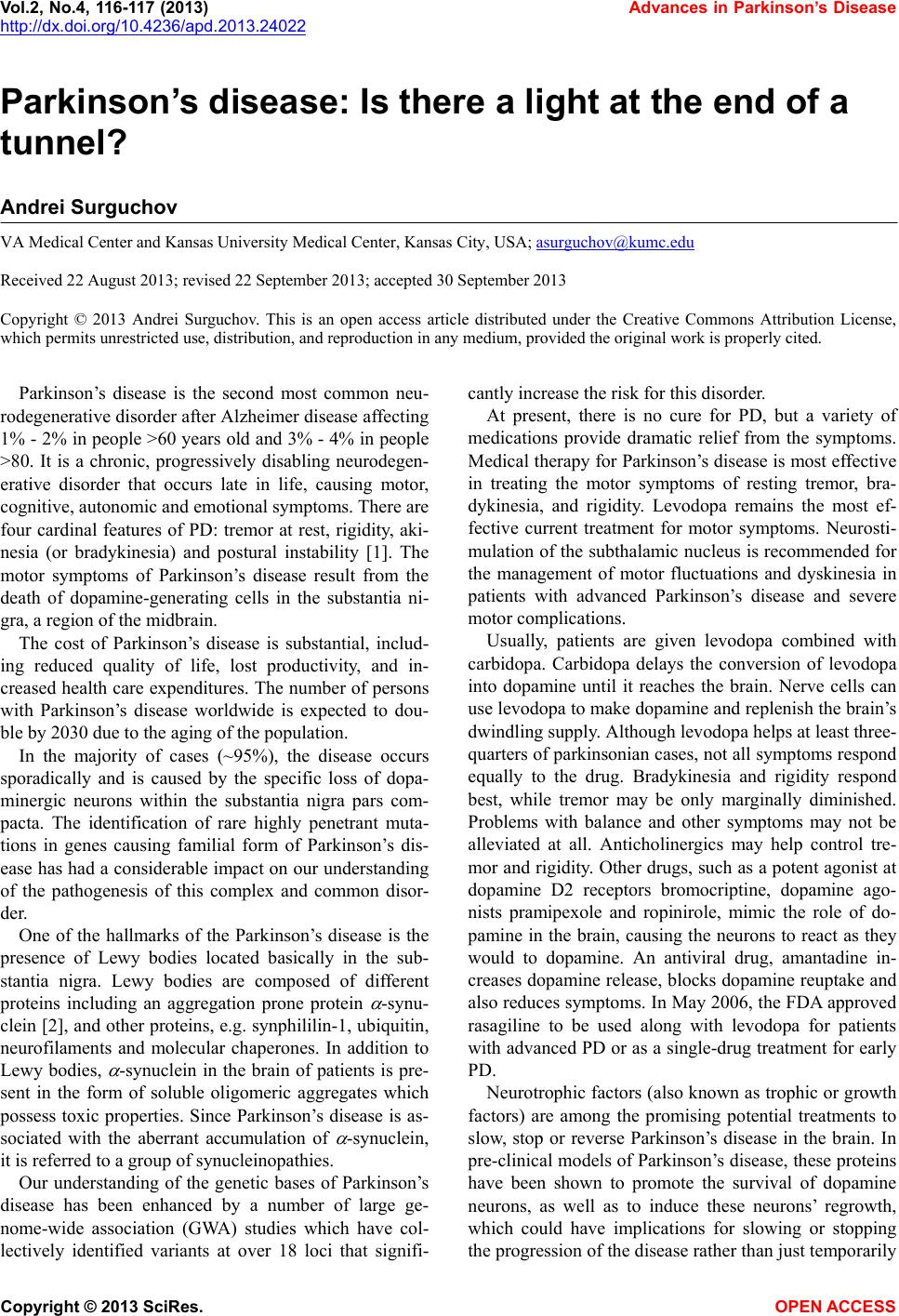
Vol.2, No.4, 116-117 (2013) Advances in Parkinson’s Disease
http://dx.doi.org/10.4236/apd.2013.24022
Parkinson’s disease: Is there a light at the end of a
tunnel?
Andrei Surguchov
VA Medical Center and Kansas University Medical Center, Kansas City, USA; asurguchov@kumc.edu
Received 22 August 2013; revised 22 September 2013; accepted 30 September 2013
Copyright © 2013 Andrei Surguchov. This is an open access article distributed under the Creative Commons Attribution License,
which permits unrestricted use, distribution, and reproduction in any medium, provided the original work is properly cited.
Parkinson’s disease is the second most common neu-
rodegenerative disorder after Alzheimer disease affecting
1% - 2% in people >60 years old and 3% - 4% in people
>80. It is a chronic, progressively disabling neurodegen-
erative disorder that occurs late in life, causing motor,
cognitive, autonomic and emotional symptoms. There are
four cardinal features of PD: tremor at rest, rigidity, aki-
nesia (or bradykinesia) and postural instability [1]. The
motor symptoms of Parkinson’s disease result from the
death of dopamine-generating cells in the substantia ni-
gra, a region of the midbrain.
The cost of Parkinson’s disease is substantial, includ-
ing reduced quality of life, lost productivity, and in-
creased health care expenditures. The number of persons
with Parkinson’s disease worldwide is expected to dou-
ble by 2030 due to the aging of the population.
In the majority of cases (~95%), the disease occurs
sporadically and is caused by the specific loss of dopa-
minergic neurons within the substantia nigra pars com-
pacta. The identification of rare highly penetrant muta-
tions in genes causing familial form of Parkinson’s dis-
ease has had a considerable impact on our understanding
of the pathogenesis of this complex and common disor-
der.
One of the hallmarks of the Parkinson’s disease is the
presence of Lewy bodies located basically in the sub-
stantia nigra. Lewy bodies are composed of different
proteins including an aggregation prone protein
-synu-
clein [2], and other proteins, e.g. synphililin-1, ubiquitin,
neurofilaments and molecular chaperones. In addition to
Lewy bodies,
-synuclein in the brain of patients is pre-
sent in the form of soluble oligomeric aggregates which
possess toxic properties. Since Parkinson’s disease is as-
sociated with the aberrant accumulation of
-synuclein,
it is referred to a group of synucleinopathies.
Our understanding of the genetic bases of Parkinson’s
disease has been enhanced by a number of large ge-
nome-wide association (GWA) studies which have col-
lectively identified variants at over 18 loci that signifi-
cantly increase the risk for this disorder.
At present, there is no cure for PD, but a variety of
medications provide dramatic relief from the symptoms.
Medical therapy for Parkinson’s disease is most effective
in treating the motor symptoms of resting tremor, bra-
dykinesia, and rigidity. Levodopa remains the most ef-
fective current treatment for motor symptoms. Neurosti-
mulation of the subthalamic nucleus is recommended for
the management of motor fluctuations and dyskinesia in
patients with advanced Parkinson’s disease and severe
motor complications.
Usually, patients are given levodopa combined with
carbidopa. Carbidopa delays the conversion of levodopa
into dopamine until it reaches the brain. Nerve cells can
use levodopa to make dopamine and replenish the brain’s
dwindling supply. Although levodopa helps at least three-
quarters of parkinsonian cases, not all symptoms respond
equally to the drug. Bradykinesia and rigidity respond
best, while tremor may be only marginally diminished.
Problems with balance and other symptoms may not be
alleviated at all. Anticholinergics may help control tre-
mor and rigidity. Other drugs, such as a potent agonist at
dopamine D2 receptors bromocriptine, dopamine ago-
nists pramipexole and ropinirole, mimic the role of do-
pamine in the brain, causing the neurons to react as they
would to dopamine. An antiviral drug, amantadine in-
creases dopamine release, blocks dopamine reuptake and
also reduces symptoms. In May 2006, the FDA approved
rasagiline to be used along with levodopa for patients
with advanced PD or as a single-drug treatment for early
PD.
Neurotrophic factors (also known as trophic or growth
factors) are among the promising potential treatments to
slow, stop or reverse Parkinson’s disease in the brain. In
pre-clinical models of Parkinson’s disease, these proteins
have been shown to promote the survival of dopamine
neurons, as well as to induce these neurons’ regrowth,
which could have implications for slowing or stopping
the progression of the disease rather than just temporarily
Copyright © 2013 SciRes. OPEN A CCESS